These are some of the sites I saw when I visited Orkney in 2016 and 2018. I had been there about 20 years ago but with time only to see these briefly. In 2016 I went with Orkney Archeology Tours and had a whole week. I can recommend their tour. Early man came to Orkney probably from Doggerland, the land which was slowly covered by the North Sea as sea levels rose. Orkney lies in the Gulf stream and as a result has a warmer climate than might be expected from its position in the north of Scotland. From 4000 to 2000 BC neolithic man built settled villages, dry stone walled tombs, and ceremonial monuments such as stone circles and standing stones. Because the island was not intensively farmed, many of these survive. If you click on the photos, most of them come up larger. (Some don’t. I don’t know why!!).
The only Neolithic rock cut tomb in Britain – if it is Neolithic. It is possibly later in the bronze age. There is no way of knowing because the contents of the tomb were thrown out two or three hundred years ago. It is a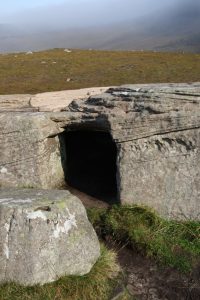 huge chunk of rock which has fallen from the escarpment behind. A tomb with two chambers has been cut into the rock itself. Outside the rock lies a shaped stone (see right) which originally blocked access. In the sixteenth century, the blocking stone was still in place but 200 years later it had been pulled out. On top of the dwarfie stane is the hole that had been used to push out the stone. This is now covered with cement. There were sea eagles nesting (unsucessfully) in the escarpment in 2016
huge chunk of rock which has fallen from the escarpment behind. A tomb with two chambers has been cut into the rock itself. Outside the rock lies a shaped stone (see right) which originally blocked access. In the sixteenth century, the blocking stone was still in place but 200 years later it had been pulled out. On top of the dwarfie stane is the hole that had been used to push out the stone. This is now covered with cement. There were sea eagles nesting (unsucessfully) in the escarpment in 2016
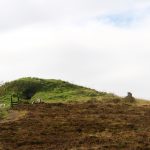 Excavated in 1901 it contained the bones of at least 18 people and – extraordinarily – those of 24 dogs,
Excavated in 1901 it contained the bones of at least 18 people and – extraordinarily – those of 24 dogs, 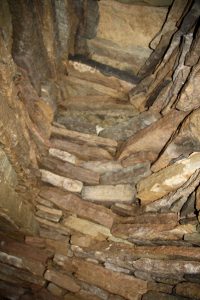 deposited later than the main human burials. A single chamber with a corbelled roof opens into four side chambers, one of them a double. There are the remains of a small neolithic village below the hill. It is necessary to crawl on hands and knees down the passage. The finely corbelling roofs of the various chambers are topped with stone slabs or in the case of the main chamber with modern concrete.
deposited later than the main human burials. A single chamber with a corbelled roof opens into four side chambers, one of them a double. There are the remains of a small neolithic village below the hill. It is necessary to crawl on hands and knees down the passage. The finely corbelling roofs of the various chambers are topped with stone slabs or in the case of the main chamber with modern concrete.
The ruined broch (the mound of stones on the left) stands in its normal context, a surrounding iron age village. There is also a later pictish house not photographed here. The broch had been partitioned inside and shored up to prevent collapse. The double ditch and bank surrounding the village seems to peter out and later houses were built over it. The broch also has a relatively extensive earth house (called a fougou in Cornwall or a souterrain in Ireland), the purpose of which is not clear.
A narrow passage leads into a huge square central chamber with an upstanding tapering orthostat at each corner and three chambers leading off it. A long low passage – you have to crouch but not go on hands and knees – leads into the fourth side of the square. Photographing the inside is now banned. The corbelled roof of the main chamber is no longer authentic as it has been strengthened with an arch and cement and painted white. To get an idea of what it would have been like, look at Cuween chambered tomb roof above. There are runic inscriptions made by Vikings. The mound is surrounded by a henge, said to be the third largest in the British Isles but I think it might be the fourth largest if you count Stanton Harcourt (see Oxfordshire page). More interesting than these is the fact that from Maes Howe you can see the Watcher stone and the Stenness stone circle and the Ring of Brodgar circle (just) from across the water (Left to right below, between the electricity poles).
These rather strange earth houses (or fogous or souterrains) are found at iron age defensive sites and were originally thought to be places where the population could hide, though very uncomfortably! The other possibility was that they were for storage, though they would have been too damp to store grain. Nowadays the hypothesis is that they have some ritual significance. This particular one had the bones of 18 people deposited in it. The entrance passage is very narrow so visitors get into the main chamber via a hatch and a ladder.
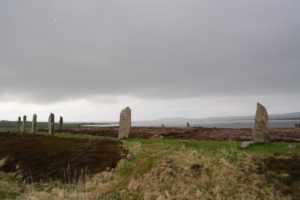 Surrounded by a henge with two entrances cut into the rock, there were once about 60 standing stones here. Now there are 27 of them some about 6ft to 15 ft high. They are set on a slope which looks towards Maes Howe. The bank of the henge can no longer be seen but a large mound, one of many mounds around the circle, has no tomb in it and might just consist of the spoil from the ditch. This is a very busy site and difficult to photograph without a drone!
Surrounded by a henge with two entrances cut into the rock, there were once about 60 standing stones here. Now there are 27 of them some about 6ft to 15 ft high. They are set on a slope which looks towards Maes Howe. The bank of the henge can no longer be seen but a large mound, one of many mounds around the circle, has no tomb in it and might just consist of the spoil from the ditch. This is a very busy site and difficult to photograph without a drone!
A neolithic village, hidden under sand dunes, discovered in 1850 but built before the larger pyramids of Egypt and lived in from about 3100 BC. Built by a loch, the ruins are now by the sea shore. The house layout is similar in most of them – an entrance from a corridor linking the various houses, a central hearth with beds either side, and a “dresser” with a mantlepiece and a storage area behind.The biggest house, House no 1, should have a storage area behind the “dresser” but this was eroded by the sea and the”window” at the right of the dresser has been wrongly rebuilt. House no 9 was built in the first phase. House no 8 had no beds but tools and pottery suggesting some kind of working room. Worth reading this on Orkney domestic architecture.
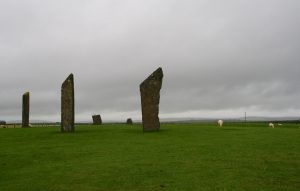 The visible bank of the henge round this stone circle has been made by archeologists. There is one entrance and it is thought that originally there were 12 standing stones. The local farm tenant Captain MacKay broke up one of the stones and pulled down a second before being stopped by the local sheriff on Christmas day 1814. A later excavation in the 1970s found animal bones of sheep, cattle and dog were found in the ditch. There is a hearth in the centre. Within the circle is a fake sacrificial stone, set up originally like a dolmen, to please Sir Walter Scott, and carefully aligned to Maes Howe! There are two outliers – the Watch Stone, the remaining one of a pair, and the Barnhouse stone. A local stone with a hole, the Odin stone, one of a pair,was broken up in 1814. The site was altered when Walter Scott thought it should have a sacrificial altar. Two stones were set flat with a third one over them like a dolmen. Then in the l970s this was toppled.
The visible bank of the henge round this stone circle has been made by archeologists. There is one entrance and it is thought that originally there were 12 standing stones. The local farm tenant Captain MacKay broke up one of the stones and pulled down a second before being stopped by the local sheriff on Christmas day 1814. A later excavation in the 1970s found animal bones of sheep, cattle and dog were found in the ditch. There is a hearth in the centre. Within the circle is a fake sacrificial stone, set up originally like a dolmen, to please Sir Walter Scott, and carefully aligned to Maes Howe! There are two outliers – the Watch Stone, the remaining one of a pair, and the Barnhouse stone. A local stone with a hole, the Odin stone, one of a pair,was broken up in 1814. The site was altered when Walter Scott thought it should have a sacrificial altar. Two stones were set flat with a third one over them like a dolmen. Then in the l970s this was toppled.
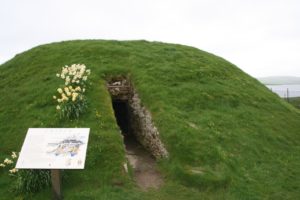 The entrance, blocked to tourists, leads to a long chamber divided into stals by upright sabs not ullike those in Blackhammer cairn (see later on this page). Bones of several people were found inside with the remains of 30 round-bottomed pottery vesssels now known as UnstanWare. There were also to later burials of individuals in a couched position, showing the tomb had been re-used at a later stage. For details of Unstan ware look here
The entrance, blocked to tourists, leads to a long chamber divided into stals by upright sabs not ullike those in Blackhammer cairn (see later on this page). Bones of several people were found inside with the remains of 30 round-bottomed pottery vesssels now known as UnstanWare. There were also to later burials of individuals in a couched position, showing the tomb had been re-used at a later stage. For details of Unstan ware look here
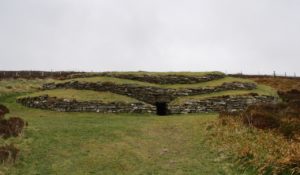 High up on a hill overlooking Kirkwall is this chambered tomb. Originally the tiered look (the result of excavation) would have been a mound covered with stones with only the small entrance showing. It is a three hour walk there and back from the Leisure Centre – the equivalent of 33 flights of stairs.
High up on a hill overlooking Kirkwall is this chambered tomb. Originally the tiered look (the result of excavation) would have been a mound covered with stones with only the small entrance showing. It is a three hour walk there and back from the Leisure Centre – the equivalent of 33 flights of stairs.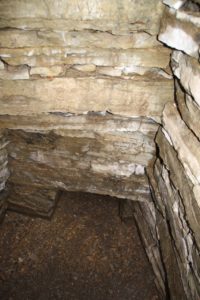 There is also a way to drive there and park, then walk a mere half hour or less over moorland. It is possible to enter the tomb from a ladder at the top. I did not do this as the tomb is very remote and I am slightly phobic of enclosed spaces. Just took a photo peering downwards showing the wonderful dry stone walling. Worth the climb for the view and the remote beauty. I have posted a short video, taken in howling wind, here.
There is also a way to drive there and park, then walk a mere half hour or less over moorland. It is possible to enter the tomb from a ladder at the top. I did not do this as the tomb is very remote and I am slightly phobic of enclosed spaces. Just took a photo peering downwards showing the wonderful dry stone walling. Worth the climb for the view and the remote beauty. I have posted a short video, taken in howling wind, here.
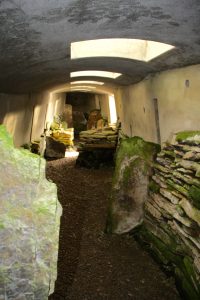 A stalled cairn of the Cromarty type without side chambers but with uprights along the chamber sometimes with shelf stones between on which are depositied bones. The wall intruding into the tomb near the entrance is that of a later house built into the tomb. Excavated in the 1930s and roofed over in concrete.
A stalled cairn of the Cromarty type without side chambers but with uprights along the chamber sometimes with shelf stones between on which are depositied bones. The wall intruding into the tomb near the entrance is that of a later house built into the tomb. Excavated in the 1930s and roofed over in concrete.
A straight central passage has upright slabs at an angle, usually described as a stalled cairn, or a cairn of the Cromarty type. (It put me in mind somewhat of the gallery graves found in the Channel Islands). No side chambers. It was originally thought that the bones inside had been defleshed. Lately it is thought that this may not be so. The cairn is huge with two retainng walls to keep the stones from slipping off. To give an idea of the work involved: modern stone walls need a ton of stone for each yard. There would have been a corbelled ceiling. This is the second largest tomb in Rousay. It was covered over and donated to the nation by Walter Grant. The outside walls of the tomb were slanted dry stone walling in a herringbone pattern. Two horns were built outward from the long side furthest from the sea perhaps to enhance visibility from the hillside – normal horns of a cairn are at the entrance.
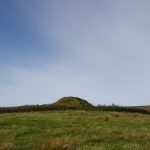 A very rare double storey cairn set on a slope. The bottom chamber was dug into the slope, on which the tomb was built. Below the top one, and the floor of the top tomb is the roof of the bottom one, but with no communicating passage between the two. The top tomb has traditional rounded chambers for remains. It was built after and on top of the lower tomb. Today a ladder takes visitors to the lower chamber which has four compartments, two separated with tall uprights and benches, like a stalled cairn. It entrance passage, pictured below, is much longer than that of the top chamber. About 20 or so feet away is a small chamber dug in the ground – too small for a modern human to enter. There were no human remains in it, just some pottery bowls so it may not have been a tomb but instead had some ceremonial purpose.
A very rare double storey cairn set on a slope. The bottom chamber was dug into the slope, on which the tomb was built. Below the top one, and the floor of the top tomb is the roof of the bottom one, but with no communicating passage between the two. The top tomb has traditional rounded chambers for remains. It was built after and on top of the lower tomb. Today a ladder takes visitors to the lower chamber which has four compartments, two separated with tall uprights and benches, like a stalled cairn. It entrance passage, pictured below, is much longer than that of the top chamber. About 20 or so feet away is a small chamber dug in the ground – too small for a modern human to enter. There were no human remains in it, just some pottery bowls so it may not have been a tomb but instead had some ceremonial purpose.
First di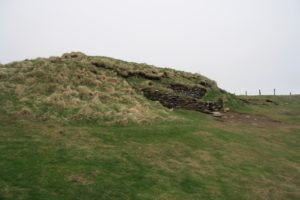 scovered in l958 this tomb looks over the cliff drop down into the sea. It contained 16,000 bones including almost 100 skulls, the largest collection of Neolithic bones in the UK. Skulls were found in the side chambers with most of the other bones in the central chamber. No skeletons were complete, possibly because they were excarnated, ie left to rot outside the tomb before being carried in.The bones of approximately 14 white tailed eagles, till very recently extinct in the UK, were also found there. These huge birds eat carrion, so possib
scovered in l958 this tomb looks over the cliff drop down into the sea. It contained 16,000 bones including almost 100 skulls, the largest collection of Neolithic bones in the UK. Skulls were found in the side chambers with most of the other bones in the central chamber. No skeletons were complete, possibly because they were excarnated, ie left to rot outside the tomb before being carried in.The bones of approximately 14 white tailed eagles, till very recently extinct in the UK, were also found there. These huge birds eat carrion, so possib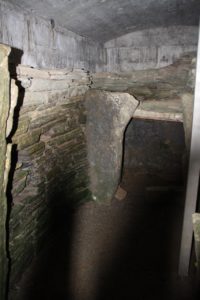 ly they played a part in de-fleshing the bones of the dead. It is possible to crawl into the tomb to see the two side cells at either end of the long rectangular chamber. Unstan pottery (see Unstan cairn entry higher up) and tools were also found. The tomb was in use from c. 4000 to 2,500 BC, after which the roof was removed and it was filled with rubble. There is a good museum on the site, run by the family of the farmer who originally found the cairn.
ly they played a part in de-fleshing the bones of the dead. It is possible to crawl into the tomb to see the two side cells at either end of the long rectangular chamber. Unstan pottery (see Unstan cairn entry higher up) and tools were also found. The tomb was in use from c. 4000 to 2,500 BC, after which the roof was removed and it was filled with rubble. There is a good museum on the site, run by the family of the farmer who originally found the cairn.
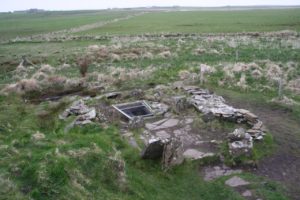 Burnt mounds are found all over Orkney and Shetland, in wet areas. They are later than the chambered cairns and have a paved area with a stone trough. ( the trough has been covered over but is still water tight.) There are usually different bays or compartments with some kind of drainage system. Burnt mounds are usually interpreted as cooking areas, where meat was boiled in the trough using heated stones. Some may have been roofed or half roofed: others are open. Were these open domestic kitchens or ceremonial feasting sites. We just don’t know
Burnt mounds are found all over Orkney and Shetland, in wet areas. They are later than the chambered cairns and have a paved area with a stone trough. ( the trough has been covered over but is still water tight.) There are usually different bays or compartments with some kind of drainage system. Burnt mounds are usually interpreted as cooking areas, where meat was boiled in the trough using heated stones. Some may have been roofed or half roofed: others are open. Were these open domestic kitchens or ceremonial feasting sites. We just don’t know